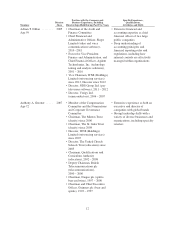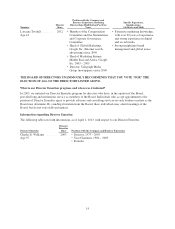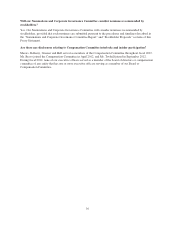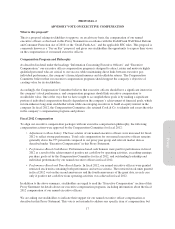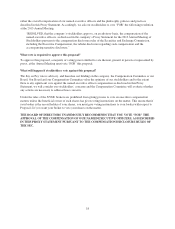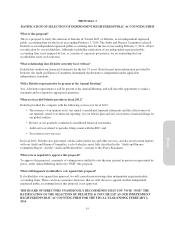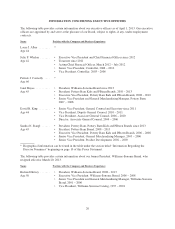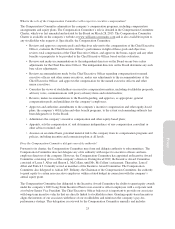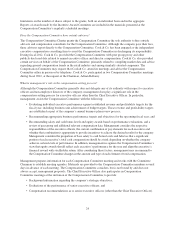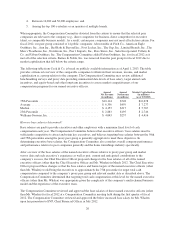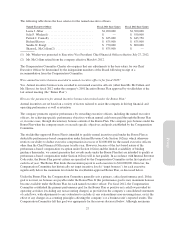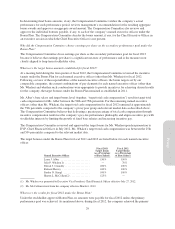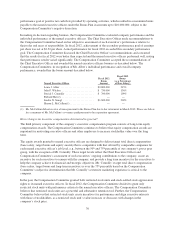Pottery Barn 2012 Annual Report Download - page 116
Download and view the complete annual report
Please find page 116 of the 2012 Pottery Barn annual report below. You can navigate through the pages in the report by either clicking on the pages listed below, or by using the keyword search tool below to find specific information within the annual report.• Commencing in 2010, not permitting personal use of our corporate aircraft; and
• Engaging Cook & Co. to perform an annual risk analysis with respect to the company’s compensation
programs and policies, including for non-executive officers.
Who serves on the Compensation Committee?
Messrs. Bellamy, Greener and Hall served as members of the Compensation Committee throughout fiscal 2012.
Ms. Bravo joined the Compensation Committee in April 2012, and Ms. Twohill joined in September 2012.
Mr. Bellamy serves as Chairman of the Compensation Committee. The Board determined that, in fiscal 2012,
each member of the Compensation Committee was independent under the NYSE rules as currently in effect, was
an outside director as such term is defined with respect to Section 162(m) of the Internal Revenue Code and was
a non-employee director under Section 16(b) of the Securities Exchange Act of 1934. None of the Compensation
Committee members has ever served as an officer of the company.
How many times did the Compensation Committee meet during fiscal 2012?
The Compensation Committee held a total of seven meetings during fiscal 2012. The Compensation Committee
also met in executive session without management present at a number of these meetings.
What is the Compensation Committee’s philosophy of executive compensation?
The Compensation Committee believes that the company’s executive compensation programs should support the
company’s objectives of creating value for its stockholders by rewarding long-term stockholder value creation
and providing competitive pay opportunities to attract and retain highly qualified executive talent. Accordingly,
the Compensation Committee believes that executive officers and other key employees should have a significant
interest in the company’s stock performance, and incentive programs should link executive compensation to
stockholder value. The Compensation Committee strives to ensure that the company’s executive compensation
programs maintain direct links between executive pay and performance, including individual performance, the
company’s financial performance, and stockholder returns.
The Compensation Committee has sought to accomplish these goals by properly balancing the elements of the
executive compensation program (e.g., fixed versus incentive, short-term versus long-term, and cash versus
equity). A significant portion of each individual’s compensation opportunity is directly dependent on the
company’s achievement of financial goals, with an opportunity for significant rewards when those goals are
exceeded. The Compensation Committee believes that superior financial performance, on a sustained basis, is an
effective means of enhancing long-term stockholder return. Since there is no pre-established policy or formal
target for the allocation between cash and non-cash compensation and short-term and long-term compensation,
the Compensation Committee reviews and determines the appropriate level and mix of compensation to meet
these goals on an ongoing basis. The Compensation Committee favors stability in the executive compensation
structure, but supports modifications that reinforce the philosophy and objective described above. The
Compensation Committee also retained Cook & Co. to evaluate the risk inherent in the company’s executive and
non-executive compensation programs.
Did the Compensation Committee consider the results of the 2012 advisory vote on executive compensation?
On May 24, 2012, we held a stockholder advisory vote on the compensation of our named executive officers,
commonly referred to as a Say on Pay advisory vote. Our stockholders approved the compensation of our named
executive officers, on an advisory basis, with over 95% of stockholder votes cast in favor of our 2012 Say on Pay
resolution. Given this result, the Compensation Committee decided to retain our overall approach to executive
compensation. Moreover, in determining how often to hold a stockholder advisory vote on executive
compensation, the Board took into account our stockholders’ preference (approximately 90% of votes cast) for an
annual vote at the 2011 annual meeting of stockholders. Specifically, the Board determined that we will hold an
annual advisory stockholder vote on our named executive officer compensation until considering the results of
our next Say on Pay frequency vote.
22


